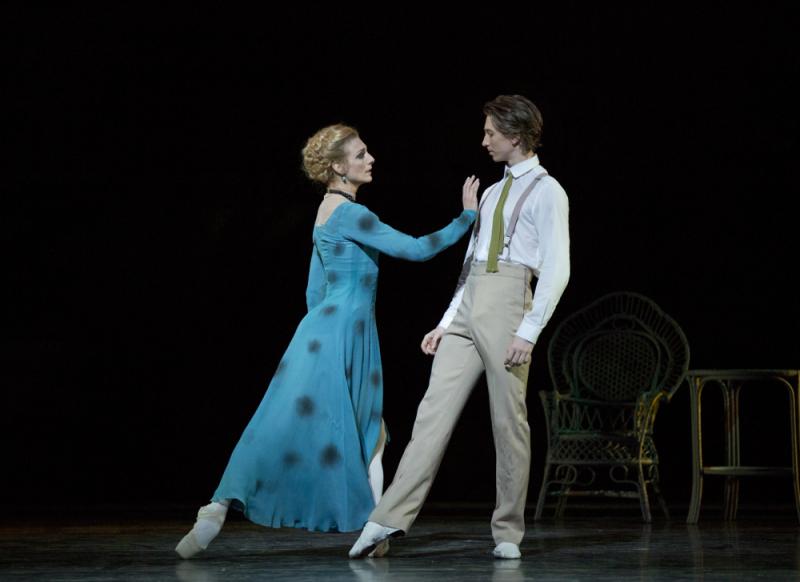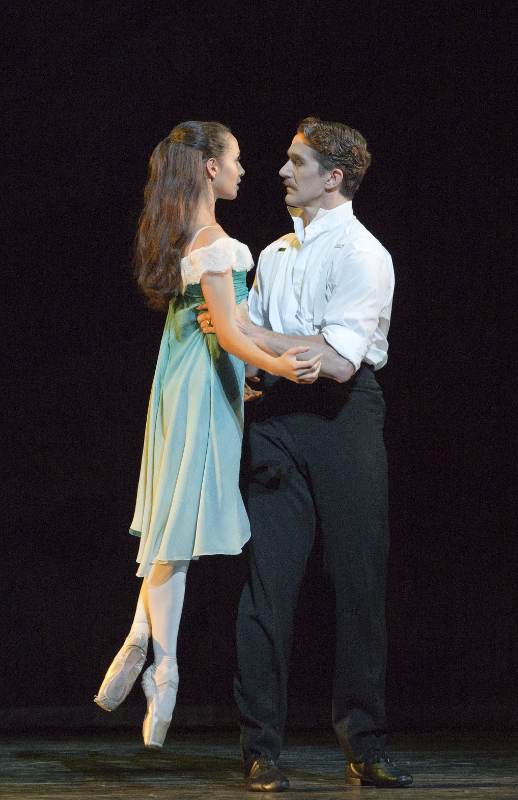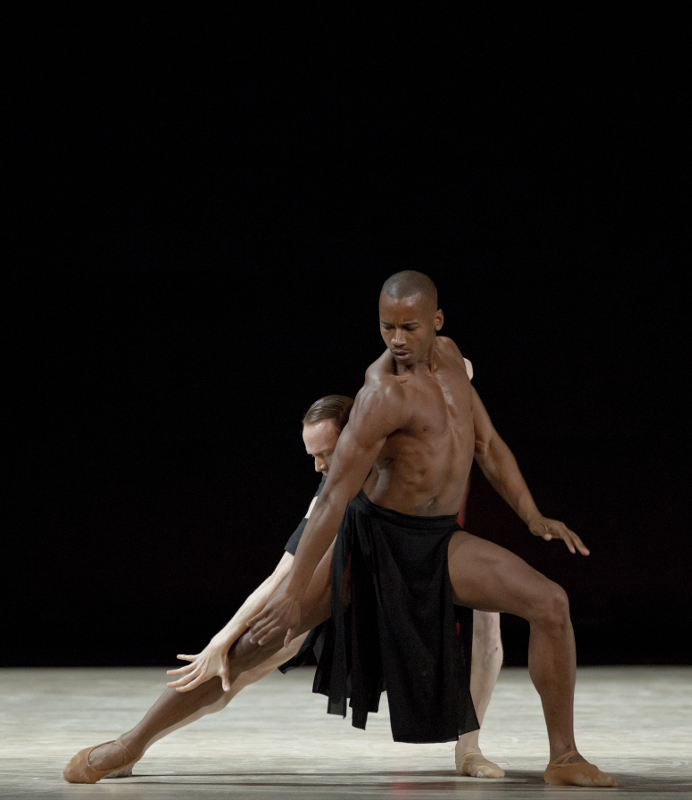The Invitation/Obsidian Tear/Within the Golden Hour, Royal Ballet | reviews, news & interviews
The Invitation/Obsidian Tear/Within the Golden Hour, Royal Ballet
The Invitation/Obsidian Tear/Within the Golden Hour, Royal Ballet
MacMillan revival in a different class to anodyne offerings from McGregor and Wheeldon

It shows you just how much Kenneth MacMillan changed ballet in this country that 1960's The Invitation, with its onstage rape, sexual grooming and child abuse, can act as the reassuring classic at the heart of the new Royal Ballet triple bill which opened on Saturday.
The setting is a Riviera villa somewhere in the early 20th century, though the murky green lighting makes it look rather more mid-Victorian than Roaring Twenties – but then it's precisely the collision of the two cultures, the uneasy coexistence of prudishness and licentiousness, that The Invitation indicts. The opening scene is heavily suggestive, as the lady of the house covers up naked statues with modest dust sheets – only for a group of teasing adolescents to take them off again and force Francesca Hayward's innocent Girl to put her face to a male statue's crotch. The childish romance between the perfectly cast Hayward, a dainty slip of a thing in a white frilly dress, and her cousin (the equally well cast Vadim Muntagirov) has barely been expressed, in a luminous little pas de deux which culminates in a poignantly angelic lift, before it is submerged in the corrupting atmosphere of the adult party. The evening's entertainment is a sleazy masque of male cocks fighting over a female (the lithe and elegant Mayara Magri), and all the couples are playing dangerous sex games.

Gary Avis and Zenaida Yanowsky are the older couple who will spoil youth's innocence, the man a stocky figure tense with aggression which he takes out on his beautiful, needy wife. In the programme, Avis speculates that his character's rape of the young Girl might be a mistake (because she, fascinated by his admiring gaze, comes to him in a nightgown) but I'd call that wishful thinking, if not victim-shaming (pictured right: Hayward and Avis). The choreography shows no seduction gone wrong but a violent, and inventively varied, series of violations, in which the Girl is entirely in the older man's power: she barely even touches the floor as he throws her about in ingenious lifts which, however disturbing to watch, are also brilliantly original (worlds away from the bland grinding of Christopher Wheeldon's recent Strapless).
Yanowsky's encounter with Muntagirov is bloodless by comparison, showing a gendered double standard in which the male youth is barely scarred by his brush with adult sexuality, while the girl is ruined not just by her physical trauma but by the social stigma which will result – predicted in the chilling scene in which Yanowsky clocks what has happened and chooses solidarity with her husband, rather than his victim. However mannered its representation, this is a fully realised world and the setting for a heartfelt social critique, which makes one feel all over again the thrill of MacMillan's talent for taking ballet to very real places full of intelligible action.
Tear can be pronounced to mean either a teardrop or a ripNext to The Invitation, McGregor's Obsidian Tear appears as a particularly unintelligible blend of abstraction and woo-woo. One of the two mildly atmospheric Esa-Pekka Salonen pieces which form the score is called Nyx, after a primordial night goddess in Greek mythology, while obsidian is a black stone associated with ritual magic, and also with a Native American story about trapped warriors who leap off a cliff to their doom. Tear, if you are wondering, could be pronounced to mean either a teardrop or a rip; the homography, McGregor reveals in the programme, helps suggest the violent quality of grief, also picked up in the title by Salonen's other piece, Lachen verlernt, the German for laughter unlearned or forgotten.
What any of this has to do with what happens on stage is an utter mystery – doubtless intentional, since McGregor always likes to claim he's one step ahead of everybody else. In the programme note, he proclaims, "I want meaning to be readily accessible, but at other times remote. I want the audience to navigate an individual journey through those moments because that reflects our experience of living. We don't 'understand' everything all of the time."
 Presumably this means I shouldn't object to Obsidian Tear's incomprehensibility, but I can't help it: the piece is spectacularly weird. My best guess is that Edward Watson is the brooding leader of an all-male cult, to which Matthew Ball brings elegant Calvin Richardson as a sacrificial victim of whom he (Ball) then becomes fond. This leaves Ball, understandably, sad after Watson makes him throw Richardson into a molten crevasse. Yes, really. The purpose of the cult is unclear: it might be sex (Watson seems to have it off with preening beauty Eric Underwood, pictured left with Watson), but it definitely requires the wearing of designer clothes "distilled" to their essence by Katie Shillingford - who reveals that a surprising number of big-name international fashion designers are inspired by judo pants. The dance is interesting in parts, with lovely expressive arm gestures for Ball and Richardson in the beginning duet and some inventive group dynamics in the second section, but mostly the piece seems wilfully esoteric.
Presumably this means I shouldn't object to Obsidian Tear's incomprehensibility, but I can't help it: the piece is spectacularly weird. My best guess is that Edward Watson is the brooding leader of an all-male cult, to which Matthew Ball brings elegant Calvin Richardson as a sacrificial victim of whom he (Ball) then becomes fond. This leaves Ball, understandably, sad after Watson makes him throw Richardson into a molten crevasse. Yes, really. The purpose of the cult is unclear: it might be sex (Watson seems to have it off with preening beauty Eric Underwood, pictured left with Watson), but it definitely requires the wearing of designer clothes "distilled" to their essence by Katie Shillingford - who reveals that a surprising number of big-name international fashion designers are inspired by judo pants. The dance is interesting in parts, with lovely expressive arm gestures for Ball and Richardson in the beginning duet and some inventive group dynamics in the second section, but mostly the piece seems wilfully esoteric.
Wheeldon's Within the Golden Hour is, by comparison, inoffensive, but there's little more to be said for it than that. It's pretty and fluid, like most things made for San Francisco Ballet (its original commissioners), it's set to bland orchestral wallpaper by Ezio Bosso, and the Royal's competent dancers go through the motions with no obvious sign of heart or soul engaged. Contemporary ballet, performed by one of the world's top dance companies, should be so much better than this.
rating
Explore topics
Share this article
The future of Arts Journalism
You can stop theartsdesk.com closing!
We urgently need financing to survive. Our fundraising drive has thus far raised £49,000 but we need to reach £100,000 or we will be forced to close. Please contribute here: https://gofund.me/c3f6033d
And if you can forward this information to anyone who might assist, we’d be grateful.

Subscribe to theartsdesk.com
Thank you for continuing to read our work on theartsdesk.com. For unlimited access to every article in its entirety, including our archive of more than 15,000 pieces, we're asking for £5 per month or £40 per year. We feel it's a very good deal, and hope you do too.
To take a subscription now simply click here.
And if you're looking for that extra gift for a friend or family member, why not treat them to a theartsdesk.com gift subscription?
more Dance
 'We are bowled over!' Thank you for your messages of love and support
Much-appreciated words of commendation from readers and the cultural community
'We are bowled over!' Thank you for your messages of love and support
Much-appreciated words of commendation from readers and the cultural community
 iD-Reloaded, Cirque Éloize, Marlowe Theatre, Canterbury review - attitude, energy and invention
A riotous blend of urban dance music, hip hop and contemporary circus
iD-Reloaded, Cirque Éloize, Marlowe Theatre, Canterbury review - attitude, energy and invention
A riotous blend of urban dance music, hip hop and contemporary circus
 How to be a Dancer in 72,000 Easy Lessons, Teaċ Daṁsa review - a riveting account of a life in dance
Michael Keegan-Dolan's unique hybrid of physical theatre and comic monologue
How to be a Dancer in 72,000 Easy Lessons, Teaċ Daṁsa review - a riveting account of a life in dance
Michael Keegan-Dolan's unique hybrid of physical theatre and comic monologue
 A Single Man, Linbury Theatre review - an anatomy of melancholy, with breaks in the clouds
Ed Watson and Jonathan Goddard are extraordinary in Jonathan Watkins' dance theatre adaptation of Isherwood's novel
A Single Man, Linbury Theatre review - an anatomy of melancholy, with breaks in the clouds
Ed Watson and Jonathan Goddard are extraordinary in Jonathan Watkins' dance theatre adaptation of Isherwood's novel
 Peaky Blinders: The Redemption of Thomas Shelby, Rambert, Sadler's Wells review - exciting dancing, if you can see it
Six TV series reduced to 100 minutes' dance time doesn't quite compute
Peaky Blinders: The Redemption of Thomas Shelby, Rambert, Sadler's Wells review - exciting dancing, if you can see it
Six TV series reduced to 100 minutes' dance time doesn't quite compute
 Giselle, National Ballet of Japan review - return of a classic, refreshed and impeccably danced
First visit by Miyako Yoshida's company leaves you wanting more
Giselle, National Ballet of Japan review - return of a classic, refreshed and impeccably danced
First visit by Miyako Yoshida's company leaves you wanting more
 Quadrophenia, Sadler's Wells review - missed opportunity to give new stage life to a Who classic
The brilliant cast need a tighter score and a stronger narrative
Quadrophenia, Sadler's Wells review - missed opportunity to give new stage life to a Who classic
The brilliant cast need a tighter score and a stronger narrative
 The Midnight Bell, Sadler's Wells review - a first reprise for one of Matthew Bourne's most compelling shows to date
The after-hours lives of the sad and lonely are drawn with compassion, originality and skill
The Midnight Bell, Sadler's Wells review - a first reprise for one of Matthew Bourne's most compelling shows to date
The after-hours lives of the sad and lonely are drawn with compassion, originality and skill
 Ballet to Broadway: Wheeldon Works, Royal Ballet review - the impressive range and reach of Christopher Wheeldon's craft
The title says it: as dancemaker, as creative magnet, the man clearly works his socks off
Ballet to Broadway: Wheeldon Works, Royal Ballet review - the impressive range and reach of Christopher Wheeldon's craft
The title says it: as dancemaker, as creative magnet, the man clearly works his socks off
 The Forsythe Programme, English National Ballet review - brains, beauty and bravura
Once again the veteran choreographer and maverick William Forsythe raises ENB's game
The Forsythe Programme, English National Ballet review - brains, beauty and bravura
Once again the veteran choreographer and maverick William Forsythe raises ENB's game
 Sad Book, Hackney Empire review - What we feel, what we show, and the many ways we deal with sadness
A book about navigating grief feeds into unusual and compelling dance theatre
Sad Book, Hackney Empire review - What we feel, what we show, and the many ways we deal with sadness
A book about navigating grief feeds into unusual and compelling dance theatre
 Balanchine: Three Signature Works, Royal Ballet review - exuberant, joyful, exhilarating
A triumphant triple bill
Balanchine: Three Signature Works, Royal Ballet review - exuberant, joyful, exhilarating
A triumphant triple bill

Add comment